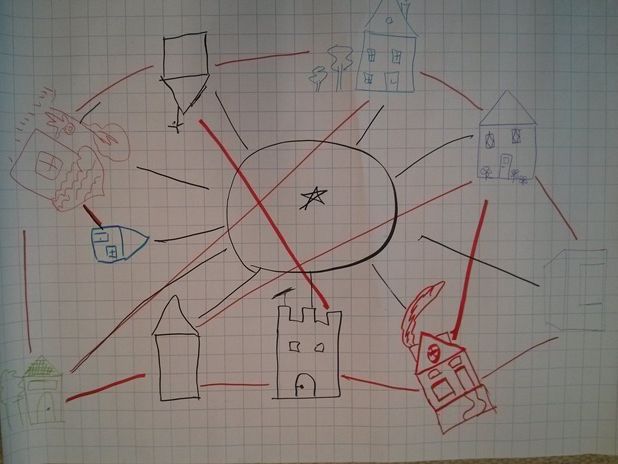Swarm Electrification - A Paradigm Change: Building a Micro-Grid from the Bottom-up
Why Swarm Electrification?
Imagine a Beach party in central Africa far away from the big cities: flashing lights, loud music, laughter. The scene we saw was made possible by a mini grid - a single photovoltaic module feeding one battery had not made it possible.
In Germany there is a 100% electrical grid connection which amounts to 0.8 billion people - but according to the United Nations Foundation worldwide 1.3 billion people lack that access. In India the percentage of people who lack access to electricity amounted to 34% in 2009.[1] Another billion of those who are electrified are only provided poor quality: electricity comes only limited time of the day and short cuts are experienced regularly.
For the research team of “Microenergy-Systems” at the Technical University (TU) of Berlin this seems like a huge market for innovative approaches. Especially because the experts from the International Energy Agency (IEA) expect in their “Energy for All Case” that 70% of the non-electrified rural areas cannot be reached with centralized grids but with mini-grids or stand-alone off-grid solutions.
Energy access in developing countries can be classified in three categories:
- In urban regions people could be classified as temporarily on-grid. So even if energy prices in for example India are much lower than in Germany this still means no advantage when this electricity comes with much poorer quality.
- In suburban areas poor people can live insight of electrical land lines but without having there own connection. The needed transformer station is what provides a lot of costs – an official program would be needed to subsidize the electrification. From a new perspective people living here could be called close-to-grid. For these Solar Home Systems (SHS) would seem like the second best solution.
- But the topic here is yet another. It is about rural population being classified as off-grid. To change these peoples life to the better a new perspective can be helpful. Calling them people far-from-grid.
But waiting for political policies to change facing the task of connecting far rural areas doesn’t seem to be satisfying. By installing SHS, diesel generators and other electricity producing systems and connecting them to form mini grids rural population could experience a proactive way.
What is Swarm Electrification?
The approach sees households and small businesses in rural undeveloped areas as the basis for the development of a micro empowerment from the buttom-up. The implementation of this new technological approach is end-user financed by providing micro loans according to the example of the Grameen Bank.
A premise to install a swarm grid is an off-grid village with some installed generators. Usually that would be Solar Home Systems which operate according to the presented slides with
- 20 to 85 Wp photovoltaic panels
- Lead acid batteries
- Efficient 12 V direct current (DC) loads (e.g. LED lights)
These systems generally have a payback period of one to three years and can guarantee three days of electricity autonomy in case of cloudy conditions.
Energy and Food from the Soil - Competitors and/or Synergists?
(Incl. Overview on Microenergy-systems & Agriculture)
What does it mean to have a competition for soil? It can be:
- Quantitative: concerning the amount of land used→impact now
Systems Creating Open Cycles
Waste
More research needs to be done on using waste materials such as harvest residues and kitchen waste for biogas production; challenges are e.g. to gain process stability by using inhomogenous materials; research work is tackling this (e.g. TU Berlin, ATB Potsdam-Barnim, TU Hamburg-Harburg).
Environmental Pollution
The Potential of Using Reclaimed Bio-Slurry as Fertiliser
Further Information
- IAASTD (2009) International Assessment of Agricultural Knowledge, Science and Technology for Development, Synthesis Report, Island Press, Washington, DC,ISBN 978-1-59726-550-8, 106pp.
- FIAN 2012:http://www.fian-deutschland.de/online/index.php?option=com_content&view=article&id=68&Itemid=176; visited at 26th Feb. 2013.
- UNEP 2011: Decoupling natural resource use and environmental impacts from economic growth, A Report of the Working Group on Decoupling to the International Resource Panel. Fischer-Kowalski, M., Swilling, M., von Weizsäcker, E.U., Ren, Y., Moriguchi, Y., Crane, W., Krausmann, F., Eisenmenger, N., Giljum, S., Hennicke, P., Romero Lankao, P., Siriban Manalang, A.
- UNEP 2010: Assessing the Environmental Impacts of Consumption and Production: Priority Products and Materials, A Report of the Working Group on the Environmental Impacts of Products and Materials to the International Panel for Sustainable Resource Management. Hertwich, E., van der Voet, E., Suh, S., Tukker, A, Huijbregts M., Kazmierczyk, P., Lenzen, M., McNeely, J., Moriguchi, Y.
References
This article is based on the proceedings of the session "MES & Agriculture" at the Micro Perspectives for Decentralized Energy Supply Conference - 2013 at University of Technology in Berlin with the following oral presentations:




















